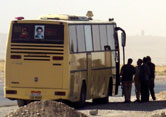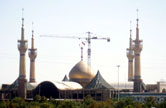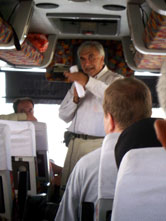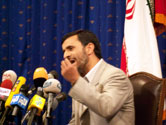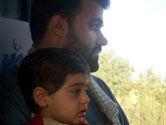WIDE ANGLE travels with a busload of Shia pilgrims as they make their way from Iran to Iraq to visit Karbala, among the holiest sites in Shia Islam. Pilgrims travel to Karbala year-round to honor Hussein, the martyred grandson of the Prophet Muhammad, whose murder, in part, caused the schism between the Sunni and Shia. In the time of Saddam such observances were banned, but in wartime Iraq, marked by vicious sectarian violence, the pilgrimage is more dangerous than it has been in years. In PILGRIMAGE TO KARBALA we examine the roots of the Islamic schism, and see how an ancient murder affects the people of the Persian Gulf to this day.
In the below excerpted article, Vali Nasr explains the connections between the Shia in Iran and Iraq, and discusses how the war in Iraq has caused a power shift in the Middle East, with the Shia ascending.
Reprinted from the From July/August 2006 edition of FOREIGN AFFAIRS
The war in Iraq has profoundly changed the Middle East, although not in the ways that Washington had anticipated. When the U.S. government toppled Saddam Hussein in 2003, it thought regime change would help bring democracy to Iraq and then to the rest of the region. The Bush administration thought of politics as the relationship between individuals and the state, and so it failed to recognize that people in the Middle East see politics also as the balance of power among communities. Rather than viewing the fall of Saddam as an occasion to create a liberal democracy, therefore, many Iraqis viewed it as an opportunity to redress injustices in the distribution of power among the country’s major communities. By liberating and empowering Iraq’s Shiite majority, the Bush administration helped launch a broad Shiite revival that will upset the sectarian balance in Iraq and the Middle East for years to come.
There is no such thing as pan-Shiism, or even a unified leadership for the community, but Shiites share a coherent religious view: since splitting off from the Sunnis in the seventh century over a disagreement about who the Prophet Muhammad’s legitimate successors were, they have developed a distinct conception of Islamic laws and practices. And the sheer size of their population today makes them a potentially powerful constituency. Shiites account for about 90 percent of Iranians, some 70 percent of the people living in the Persian Gulf region, and approximately 50 percent of those in the arc from Lebanon to Pakistan — some 140 million people in all. Many, long marginalized from power, are now clamoring for greater rights and more political influence. Recent events in Iraq have already mobilized the Shiites of Saudi Arabia (about 10 percent of the population); during the 2005 Saudi municipal elections, turnout in Shiite-dominated regions was twice as high as it was elsewhere. Hassan al-Saffar, the leader of the Saudi Shiites, encouraged them to vote by comparing Saudi Arabia to Iraq and implying that Saudi Shiites too stood to benefit from participating. The mantra “one man, one vote,” which galvanized Shiites in Iraq, is resonating elsewhere. The Shiites of Lebanon (who amount to about 45 percent of the country’s population) have touted the formula, as have the Shiites in Bahrain (who represent about 75 percent of the population there), who will cast their ballots in parliamentary elections in the fall.
Iraq’s liberation has also generated new cultural, economic, and political ties among Shiite communities across the Middle East. Since 2003, hundreds of thousands of pilgrims, coming from countries ranging from Lebanon to Pakistan, have visited Najaf and other holy Shiite cities in Iraq, creating transnational networks of seminaries, mosques, and clerics that tie Iraq to every other Shiite community, including, most important, that of Iran. Pictures of Iran’s supreme religious leader, Ayatollah Ali Khamenei, and the Lebanese cleric Muhammad Hussein Fadlallah (often referred to as Hezbollah’s spiritual leader) are ubiquitous in Bahrain, for example, where open displays of Shiite piety have been on the rise and once-timid Shiite clerics now flaunt traditional robes and turbans. The Middle East that will emerge from the crucible of the Iraq war may not be more democratic, but it will definitely be more Shiite.
It may also be more fractious. Just as the Iraqi Shiites’ rise to power has brought hope to Shiites throughout the Middle East, so has it bred anxiety among the region’s Sunnis. De-Baathification, which removed significant obstacles to the Shiites’ assumption of power in Iraq, is maligned as an important cause of the ongoing Sunni insurgency. The Sunni backlash has begun to spread far beyond Iraq’s borders, from Syria to Pakistan, raising the specter of a broader struggle for power between the two groups that could threaten stability in the region. King Abdullah of Jordan has warned that a new “Shiite crescent” stretching from Beirut to Tehran might cut through the Sunni-dominated Middle East…
Yet the emerging Shiite revival need not be a source of concern for the United States, even though it has rattled some U.S. allies in the Middle East. In fact, it presents Washington with new opportunities to pursue its interests in the region. Building bridges with the region’s Shiites could become the one clear achievement of Washington’s tortured involvement in Iraq. Succeeding at that task, however, would mean engaging Iran, the country with the world’s largest Shiite population and a growing regional power, which has a vast and intricate network of influence among the Shiites across the Middle East, most notably in Iraq. U.S.-Iranian relations today tend to center on nuclear issues and the militant rhetoric of Iran’s leadership. But set against the backdrop of the war in Iraq, they also have direct implications for the political future of the Shiites and that of the Middle East itself.
Since 2003, Iran has officially played a constructive role in Iraq. It was the first country in the region to send an official delegation to Baghdad for talks with the Iraqi Governing Council, in effect recognizing the authority that the United States had put in power. Iran extended financial support and export credits to Iraq and offered to help rebuild Iraq’s energy and electricity infrastructure. After former Prime Minister Ibrahim al-Jaafari’s Shiite-led interim government assumed office in Baghdad in April 2005, high-level Iraqi delegations visited Tehran, reached agreements over security cooperation with Iran, and negotiated a $1 billion aid package for Iraq and several trade deals, including one for the export of electricity to Iraq and another for the exchange of Iraqi crude oil for refined oil products.
Iran’s unofficial influence in Iraq is even greater. In the past three years, Iran has built an impressive network of allies and clients, ranging from intelligence operatives, armed militias, and gangs to, most visibly, politicians in various Iraqi Shiite parties. Many leaders of the main Shiite parties, the Supreme Council for the Islamic Revolution in Iraq (SCIRI) and Dawa (including two leading party spokesmen, former Prime Minister Jaafari and the current prime minister, Nouri al-Maliki), spent years of exile in Iran before returning to Iraq in 2003. (SCIRI’s militia, the Badr Brigades, was even trained and equipped by Iran’s Revolutionary Guards.) Iran has also developed ties with Muqtada al-Sadr, who once inflamed passions with his virulent anti-Iranian rhetoric, as well as with factions of Sadr’s movement, such as the Fezilat Party in Basra. The Revolutionary Guards supported Sadr’s Mahdi Army in its confrontation with U.S. troops in Najaf in 2004, and since then Iran has trained Sadrist political and military cadres. Iran bankrolled Shiite parties in Iraq during the two elections, used its popular satellite television network al Aalam to whip up support for them, and helped broker deals with the Kurds. Iraqi Shiite parties attract voters by relying on vast political and social-service networks across southern Iraq that, in many cases, were created with Iranian funding and assistance.
Throughout the 1980s and after the anti-Shiite massacres of 1991, some 100,000 Iraqi Arab Shiites also took refuge in Iran. In the dark years of the 1990s, Iran alone gave Iraqi Shiites refuge and support. Since the Iraq war, many of these refugees have returned to Iraq; they can now be found working in schools, police stations, mosques, bazaars, courts, militias, and tribal councils from Baghdad to Basra, as well as in government. The repeated shuttling of Shiites between Iran and Iraq over the years has created numerous, layered connections between the two countries’ Shiite communities. As a result, the Iraqi nationalism that the U.S. government hoped would serve as a bulwark against Iran has proved porous to Shiite identity in many ways.
Ties between the two countries’ religious communities are especially close. Iraqi exiles in Iran gravitated toward Iraqi ayatollahs such as Mahmoud Shahroudi (the head of Iran’s judiciary), Kazem al-Haeri (a senior Sadrist ayatollah), and Muhammad Baqer al-Hakim (a SCIRI leader, killed in 2003), who oversaw the establishment of Iraqi religious organizations in Tehran and Qom. Those organizations have wielded great influence in Iran since the 1980s thanks to the role they played then in opening up the Shiites of Lebanon, who had traditionally been turned toward Najaf, to Iranian influence. Many senior clerics and graduates of the Iraqi Shiite seminaries in Iran have joined Iran’s political establishment. Several judges in the Iranian judiciary, including Shahroudi, are Iraqis and are particularly close to Khamenei. And those Iraqi clerics who returned to their homeland after 2003 to take over various mosques and seminaries across southern Iraq have created an important axis of cooperation between Qom and Najaf.
So much, then, for the conventional wisdom prevailing in Washington before the war: that once Iraq was free, Najaf would rival Qom and challenge the Iranian ayatollahs. Since 2003, the two cities have cooperated. There is no visible doctrinal rift between their clerics or any exodus of dissidents from one city to the other. Grand Ayatollah Ali al-Sistani’s popular Web site, www.sistani.org, is headquartered in Qom, and most of the religious taxes collected by his representatives are kept in Iran. Despite repeated entreaties from dissident voices in Iran, senior clerics in Najaf have kept scrupulously quiet about Iranian politics, deliberately avoiding upsetting the authorities in Qom and Tehran.
This nexus extends well beyond the elites. The opening of the shrine cities of Iraq has had an emotional impact on regular Iranians, especially on the more religious social classes that support the regime. Since 2003, hundreds of thousands of Iranians have visited the holy cities of Najaf and Karbala every year. This trend has reinforced the growing popularity of devotional piety in Iran. Over the past decade, many Iranian youth have taken to adulating Shiite saints, in particular the Twelfth Imam, the Shiite messiah. Many more Iranians recognize Ayatollah Sistani as their religious leader now than did before 2003, and many more now turn their religious taxes over to him. Although largely cynical about their own clerical leaders, many Iranians have embraced the revival of Shiite identity and culture in Iraq…
Granted, the legacy of the Iran-Iraq War, Iraqi nationalism, and, especially, ethnic differences between Arabs and Persians have historically caused much friction between Iran and Iraq. But these factors should not be overemphasized: ethnic antagonism cannot possibly be all-important when Iraq’s supreme religious leader is Iranian and Iran’s chief justice is Iraqi. Although ethnicity will continue to matter to Iranian-Iraqi relations, now that Saddam has fallen and the Shiites of Iraq have risen, it will likely be overshadowed by the complex, layered connections between the two countries’ Shiite communities. These connections, moreover, are likely to be reinforced by the two communities’ perception that they face a common threat from Sunnis. Nothing seems to bring Iraqi Shiites closer to Iran than the ferocity and persistence of the Sunni insurgency — especially at a time when their trust in Washington, which has called for disbanding Shiite militias and making greater concessions to the Sunnis, is sagging…
If there is an Iranian grand strategy in Iraq today, it is to ensure that Iraq does not reemerge as a threat and that the anti-Iranian Arab nationalism championed by Sunnis does not regain primacy. Iranian President Mahmoud Ahmadinejad and many leaders of the Revolutionary Guards, all veterans of the Iran-Iraq War, see the pacification of Iraq as the fulfillment of a strategic objective they missed during that conflict. Iranians also believe that a Shiite-run Iraq would be a source of security; they take it as an axiom that Shiite countries do not go to war with one another.
All this is small consolation for the Sunnis in the region, who remember the consequences of Iran’s ideological aspirations in the 1980s — and now worry about its new regional ambitions. A quarter century ago, Tehran supported Shiite parties, militias, and insurgencies in Bahrain, Iraq, Kuwait, Lebanon, Pakistan, and Saudi Arabia. The Iranian Revolution combined Shiite identity with radical anti-Westernism, as reflected in the hostage crisis of 1979, the 1983 bombing of the U.S. Marine barracks in Beirut, and Tehran’s continued support for international terrorism. In the end, the Iranian Revolution fell short of its goals, and except for in Lebanon, the Shiite resurgence that it inspired came to naught.
Some say the Islamic Republic is now a tired dictatorship. Others, however, worry about the resurgence of Iran’s regional ambitions, fueled this time not by ideology but by nationalism. Tehran sees itself as a regional power and the center of a Persian and Shiite zone of influence stretching from Mesopotamia to Central Asia. Freed from the menace of the Taliban in Afghanistan and of Saddam in Iraq, Iran is riding the crest of the wave of Shiite revival, aggressively pursuing nuclear power and demanding international recognition of its interests.
Leaders in Tehran who want to create a greater zone of Iranian influence — something akin to Russia’s concept of “the near abroad” — view Tehran’s activities in southern Iraq as a manifestation of Iran’s great-power status. Yet none of them holds on to Khomeini’s dream of ruling over Iraq’s Shiites. Rather, Tehran’s goal in southern Iraq is to exert the type of economic, cultural, and political influence it has wielded in western Afghanistan since the 1990s. Although Tehran clearly expects to play a major role in Iraq, it may not aim — or be able — to turn the country into another Islamic republic.
Predictably, Iran’s growing prominence is complicating relations between sectarian groups in the region. Sunni governments have used Tehran’s ambitions as an excuse to resist both the demands of their own Shiite populations and Washington’s calls for political reform. Since 2003, Sunni leaders in Egypt, Jordan, and Saudi Arabia have repeatedly blamed Iran for the chaos in Iraq and warned that Iran would wield considerable influence in the region if Iraqi Shiites came to hold the reins of power in Baghdad. The Egyptian president, Hosni Mubarak, sounded the alarm last April: “Shiites are mostly always loyal to Iran and not the countries where they live.” Such partly self-serving rhetoric allows Sunni leaders to divert attention away from their own responsibility for Iraq’s troubles: Egypt, Jordan, and Saudi Arabia have so far supplied the bulk of Abu Musab al-Zarqawi’s army of suicide bombers. It also provides them with a subterfuge to resist U.S. calls for domestic political reform. If bringing democracy to the Middle East means empowering Shiites and strengthening Iran, they argue, Washington would be well advised to stick to Sunni dictatorships.
The Sunnis’ public-relations offensive worries the Iranian leadership. Despite its growing clout, Tehran needs its neighbors’ support and the goodwill of “the Arab street” to resist international pressure over its nuclear program. So far, Tehran has avoided sectarian posturing and further antagonizing Sunnis; instead, it has tried to generate support in the region by escalating tensions with the United States and Israel. Iranian leaders have routinely blamed sectarian violence in Iraq, including the bombing of the Askariya shrine, in Samarra, in February, on “agents of Zionism” intent on dividing Muslims. Meanwhile, Tehran aggressively pursues nuclear power both to confirm Iran’s regional status and to minimize Washington’s ability to stand in its way…
…if Washington and Tehran are unable to find common ground — and the constitutional negotiations fail — the consequences would be dire. At best, Iraq would go into convulsions; at worst, it would descend into full-fledged civil war. And if Iraq were to collapse, its fate would most likely be decided by a regional war. Iran, Turkey, and Iraq’s Arab neighbors would likely enter the fray to protect their interests and scramble for the scraps of Iraq. The major front would be essentially the same as that during the Iran-Iraq War, only two hundred miles further to the west: it would follow the line, running through Baghdad, that separates the predominantly Shiite regions of Iraq from the predominantly Sunni ones. Iran and the countries that supported it in the 1980s would likely back the Shiites; the countries that supported Iraq would likely back the Sunnis.
Iraq is sometimes compared to Vietnam in the early 1970s or Yugoslavia in the late 1980s, but a more relevant — and more sobering — precedent may be British India in 1947. There was no civil war in India, no organized militias, no centrally orchestrated ethnic cleansing, no battle lines, and no conflict over territory. Yet millions of people died or became refugees. British India’s professional army was sliced along communal lines as the country was partitioned into Hindu-majority and Muslim-majority regions. Unable to either bridge the widening chasm between both groups or control the violence, the British colonial administrators were forced to beat a hasty retreat. As in Iraq today, the problem in India then lay with a minority that believed in its own manifest destiny to rule and demanded, in exchange for embracing the political process, concessions from an unyielding majority. The pervasive sectarian violence and ethnic cleansing plaguing Iraq today are ominous reminders of what happened in India some 60 years ago. They may also be a worse omen: if the situation in Iraq deteriorates further, the whole Middle East would be at risk of a sectarian conflict between Shiites and Sunnis.
By Vali Nasr. Reproduced with permission from the July/August 2006 edition of FOREIGN AFFAIRS (http://www.foreignaffairs.org/).

